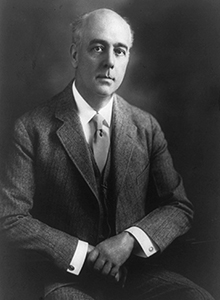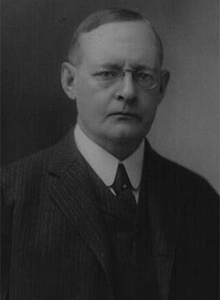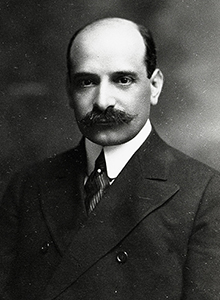
Frederic A. Delano
- Member, Board of Governors, 1916–1918
- Vice Governor [Vice Chair], Board of Governors, 1914–1916
- Born: September 10, 1863
- Died: March 28, 1953
Frederic A. Delano took office as vice chairman (called “vice governor” before 1935) of the Federal Reserve Board on August 10, 1914. He was one of the five members appointed by President Woodrow Wilson to the first Board. He held that position until August 9, 1916, and remained on the Board until July 21, 1918.
Delano was born in Hong Kong in 1863 and grew up in Newburgh, New York. In 1885, he received a bachelor’s degree from Harvard University. Delano was an uncle to Franklin Delano Roosevelt, the thirty-third president of the United States.
Before joining the Federal Reserve System, Delano was a railroad man. He began working for the Chicago, Burlington and Quincy (CB&Q) Railroad in Colorado in 1885. Over the years, he served as an apprentice machinist, rail inspector, superintendent of freight terminals and then motive power in Chicago, and eventually general manager of the CB&Q. In 1905, he became president of Wheeling and Lake Erie Railroad Co., as well as first vice president for the Wabash-Pittsburgh Terminal Railway. He became president of Wabash in 1911, then for the next two years served as one of its receivers. In 1913, Delano became president of the Chicago, Indianapolis, & Louisville Railway Company. He held this position until his appointment to the Federal Reserve Board.
Delano resigned from the Board in July 1918 to serve in World War I as command major of the US Army Corps of Engineers at Tours, France. He was promoted to lieutenant colonel of the Transportation Corps and appointed deputy director general of transportation for the American Expeditionary Forces in France in October 1918. In May 1919, he was again promoted to colonel of the Transportation Corps. Delano was honorably discharged on October 25, 1919.
In January 1920, Delano was appointed command colonel engineer for the Reserve Corps. He was awarded the US Distinguished Service Medal for service in France in 1921; the Legion of Honor (France) in 1919; and the Order of Sheng Li (Victory) from the Chinese government in 1948.
After the war, Delano became the chairman of the board of directors for the Metropolitan West Side Elevated Railroad Company as well as a director of the Union Mining Company of Maryland.
In 1921, Delano returned to Federal Reserve service, with an appointment as a Class C director at the Federal Reserve Bank of Richmond. In March 1936, he was appointed chairman of the Bank’s board of directors and served until December 1936.
Delano was a man of many talents and interests. He invented and patented a one-way window glass in 1933. He was appointed a receiver in the Red River Boundary Case, Oklahoma v. Texas, by the US Supreme Court. In addition, he was part of the League of Nation’s International Commission concerning opium production in Persia and the possible substitution of other crops or industries. He also served as a member of the Smithsonian Institution Board of Regents, trustee and chairman of the Brookings Institute, member and chairman of the National Park and Planning Commission of Washington, chairman of the National Resources Planning Board, and chairman emeritus of the American Planning and Civic Association.
Delano published many articles in scholarly journals and popular magazines on banking and finance, transportation, urban planning, and preservation of natural and community resources. Many of Delano’s personal papers are housed at the Franklin D. Roosevelt Library; his papers while in the Army can be found at the Library of Congress.
Delano died in 1953.
Written by the Board of Governors of the Federal Reserve System. See disclaimer.



